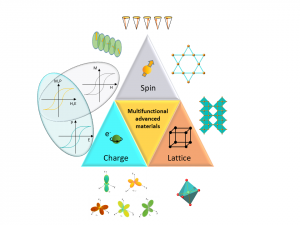Advanced electronic materials
In the modern applied and fundamental research of the utmost importance are the materials with exotic electronic states: phases in which electron interactions lead to new phenomena. The most notable example is superconductivity which is characterized by the electric current conductivity without the electric resistivity and perfect diamagnetic response to applied magnetic field occurring at low temperatures. Superconductors are extremely technologically important materials and have numerous applications: in superconducting magnets capable of producing high magnetic fields and used in scientific laboratories (condensed matter laboratories, particle accelerators, nuclear fusion experiments), and also in commercial applications (magnetism in MRI diagnostic medical technique), in transport (maglev trains), in generators, motors, cables, electronic components etc. Finding a room-temperature superconductor has been a long-standing goal of the solid state research community and is a topic in much of the current research. The magnetic order in the conventional magnets suppresses superconductivity, so it is surprising that new materials like iron pnictides and organic conductors exhibit coexistence of superconductivity with spin glasses, antiferromagnetism and other magnetic phenomena. The coexistence of the superconductivity and magnetism is a very hot topic of research in top laboratories worldwide.

Another interesting research area with great potential are low-dimensional materials in which crystal structure suppresses electron movement to only one or two dimensions. New electronic properties of low-dimensional materials accentuate the need for approach which to determine dielectric properties of the magnetic systems and vice versa. Scientists of the Institute of Physics with their experience recognize the potential of these materials in a wide range of possible applications. Also, the understanding the microscopic interactions leading to useful new properties call for the widening of the fundamental scientific research. The experimental techniques at the Institute of Physics employed for the research of these materials include magneto-transport with/without applied pressure, nonlinear conductivity, susceptibility and susceptibility anisotropy and dielectric spectroscopy. All these techniques require use of the cryogenic liquids in order to reach low temperatures and high magnetic fields.


